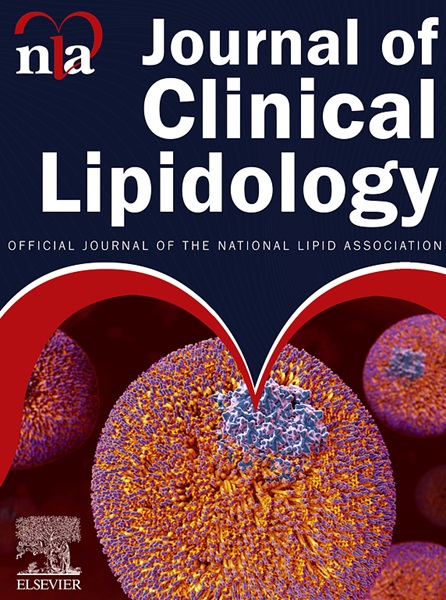Lipoprotein X – Pathophysiology, diagnosis, and management
IF 4.6
3区 医学
Q2 PHARMACOLOGY & PHARMACY
引用次数: 0
Abstract
BACKGROUND
Lipoprotein X (LpX) was first discovered in the 1960s in patients with severe cholestatic diseases as an abnormal lipoprotein that is distinct from other lipoproteins because it is not produced through regulated pathways, contains albumin as the primary protein, and is rich in free cholesterol (FC) and phospholipids. Over the next few decades, its biochemical properties and composition were characterized.
SOURCES OF MATERIAL
Elevated blood levels of LpX are now also known to occur in various other conditions, such as lecithin cholesterol acyltransferase (LCAT) deficiency, graft versus host disease, and after lipid infusions for nutritional support. LpX cannot be measured by conventional testing with a standard lipid panel. The cholesterol content of LpX is included in total cholesterol (TC) and misreported as elevated low-density lipoprotein cholesterol (LDL-C) – this is due to similar densities of LpX and LDL on ultracentrifugation. Typically, the elevations are severe in magnitude, to the extent that the standard lipid panel can look similar to a patient with homozygous familial hypercholesterolemia.
ABSTRACT OF FINDINGS
When LpX is clinically suspected, laboratory testing with measurements of apolipoprotein B, nuclear magnetic resonance (NMR) spectroscopy, lipoprotein gel electrophoresis, or measurement of FC is required to distinguish elevated levels of LpX from other forms of hypercholesterolemia, such as familial hypercholesterolemia. Being an uncommon disorder with an estimated prevalence of 0.02% to 0.09%, if LpX is not considered in the differential diagnosis, the presence of falsely reported levels of elevated LDL-C and low levels of high-density lipoprotein cholesterol (HDL-C) may mimic an atherogenic phenotype, leading to treatment with lipid-lowering therapy.
CONCLUSION
Rather than atherosclerosis, patients with increased blood LpX levels are at risk of other complications, including hyperviscosity syndrome and xanthomatosis. The usual lipid-lowering drugs do not effectively lower elevated LpX levels; thus, treatment is primarily directed at the underlying disease, with plasma exchange being reserved for hyperviscosity syndrome. This review discusses the biology, pathogenesis, clinical features, diagnosis, and management of elevated LpX levels.
脂蛋白X -病理生理,诊断和管理。
背景:脂蛋白X (Lipoprotein X, LpX)于20世纪60年代首次在严重胆汁淤积症患者中被发现,是一种不同于其他脂蛋白的异常脂蛋白,它不通过受调节的途径产生,以白蛋白为主要蛋白,富含游离胆固醇(free cholesterol, FC)和磷脂。在接下来的几十年里,人们对其生化特性和组成进行了研究。材料来源:血液中LpX水平升高现在已知也会发生在各种其他情况下,如卵磷脂胆固醇酰基转移酶(LCAT)缺乏、移植物抗宿主病和营养支持的脂质输注后。LpX不能通过标准脂质面板的常规测试来测量。LpX的胆固醇含量包含在总胆固醇(TC)中,并被误报为低密度脂蛋白胆固醇(LDL- c)升高,这是由于LpX和LDL在超离心时的密度相似。通常情况下,升高的幅度非常严重,以至于标准脂质面板看起来与纯合子家族性高胆固醇血症患者相似。结果摘要:当临床怀疑LpX时,需要通过载脂蛋白B测量、核磁共振(NMR)光谱、脂蛋白凝胶电泳或FC测量的实验室检测来区分LpX水平升高与其他形式的高胆固醇血症,如家族性高胆固醇血症。LpX是一种罕见的疾病,估计患病率为0.02%至0.09%,如果在鉴别诊断中不考虑LpX,则错误报告LDL-C升高和高密度脂蛋白胆固醇(HDL-C)低水平的存在可能模拟动脉粥样硬化表型,导致使用降脂疗法(LLT)进行治疗。结论:与动脉粥样硬化不同,血中LpX水平升高的患者有其他并发症的风险,包括高粘度综合征和黄瘤病。常用的降脂药物不能有效降低升高的LpX水平;因此,治疗主要针对基础疾病,血浆交换保留用于高粘度综合征。本文就LpX水平升高的生物学、发病机制、临床特征、诊断和治疗进行综述。
本文章由计算机程序翻译,如有差异,请以英文原文为准。
求助全文
约1分钟内获得全文
求助全文
来源期刊
CiteScore
7.00
自引率
6.80%
发文量
209
审稿时长
49 days
期刊介绍:
Because the scope of clinical lipidology is broad, the topics addressed by the Journal are equally diverse. Typical articles explore lipidology as it is practiced in the treatment setting, recent developments in pharmacological research, reports of treatment and trials, case studies, the impact of lifestyle modification, and similar academic material of interest to the practitioner.
Sections of Journal of clinical lipidology will address pioneering studies and the clinicians who conduct them, case studies, ethical standards and conduct, professional guidance such as ATP and NCEP, editorial commentary, letters from readers, National Lipid Association (NLA) news and upcoming event information, as well as abstracts from the NLA annual scientific sessions and the scientific forums held by its chapters, when appropriate.

 求助内容:
求助内容: 应助结果提醒方式:
应助结果提醒方式:


